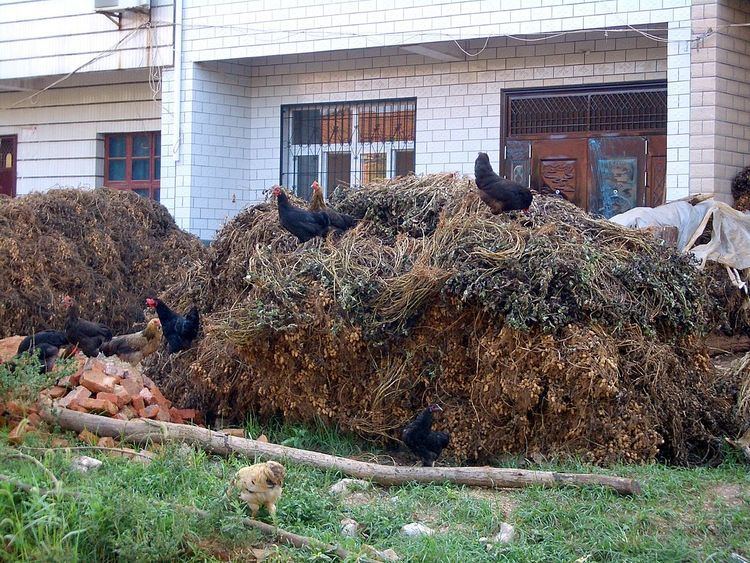 | ||
Peanut production in China contributes to the national economy. China has been the world's largest producer of peanuts by a substantial margin since at least 2006.
Contents
The peanut was introduced to China by Portuguese traders in the 17th century and another variety was provided by American missionaries in the 19th century. During the 1980s, peanut production began to increase, a major factor being the household-responsibility system, which moved financial control from the government to the farmers. By 2012 it was producing 16.7 million tonnes of peanuts annually. Peanuts are often used to make peanut oil, a popular ingredient in Chinese, South Asian and Southeast Asian cuisine. Although China is by far the world's largest producer, the per capita consumption of peanuts in China as of 2009 was stated to be comparable to that of the United States.
History
Ancient prehistory finds of the Neolithic period during archaeological excavations at Zhejiang and Jiangxi have led to a claim in China that the groundnut is an indigenous crop. The only recorded support in this claim is attributed to the Ming Dynasty's reign in the 15th century. But the modern version of peanut is dated to a period after Christopher Columbus discovered the Americas. In a vast country like China, the history of peanut's introduction varies from region to region. The earliest recorded year of growing peanuts is noted as 1368. The next recorded date is in the middle of the 19th century by American missionaries, after which the crop spread to all provinces of the country. In 1918, North China exported 70,000,000 pounds of peanuts, while South China imported 93,000,000 pounds. Historically, Honan and Chihli provinces have ranked next to Shantung in production.
Local names
Peanut is known by different names in China. These include: Changshengguo (meaning "long-life fruit"), Luohuasheng (meaning "flower-born"), Didou (meaning "earth bean"), Xiangdou (meaning "fragrant bean"), Wuhuaguo (meaning "flowerless fruit"), and Qiansuizi (meaning "thousand-year-old offspring"). It is most commonly referred to as "Huashengmi 花生米" or just "huasheng 花生".
Production
Peanuts are grown in seven regions of China based on ecological zoning, from the frigid North China to the humid region of South China, and from the eastern to western region. Temperatures in the areas producing peanuts range from −5 to 25 °C (23 to 77 °F). These regions are: Region I is "Virginia type north large peanut" region; Region II is known as "South Spring and autumn peanut area; in Region III the "Yangtze spring and summer peanut region"; Region IV is the "Yungui plateau peanut region"; Region V is the "Northeast early peanut region"; Region VI is the "Loess peanut region"; and Region VII is the "Northwest inland peanut region". The five provinces where 70% of the crop is grown are Shandong, Henan, Hebei, Guangdong, and Jiangsu provinces.
Peanut production in China has witnessed a phenomenal growth since 1961, particularly from the 1980s when the "Household Responsibility System" of cultivation became effective giving farmers the incentive of semi-private ownership rights, with the market economy giving a substantial advantage in increasing the yield per ha even though the area brought under the crop was not substantially changed; improved cultivation technology also helped in this increase.
Production in 2004 totaled more than 13 million metric tons. According to FAO statistics for 2013, the production of peanuts in China topped the list in the world with a yield of 17.02 million tons which amounted to a world share of 37.3%. This was contributed by 4.652 million ha ranking number 2 in the world but with highest yield rate of 3,659 kilograms per ha. Compared to this, India, with a larger area of 5.25 million ha ranking number 1 in the world, was way behind China production-wise, recording only 9.472 million tons at 31st position due to a low yield rate of 1,804 kilograms per ha.
